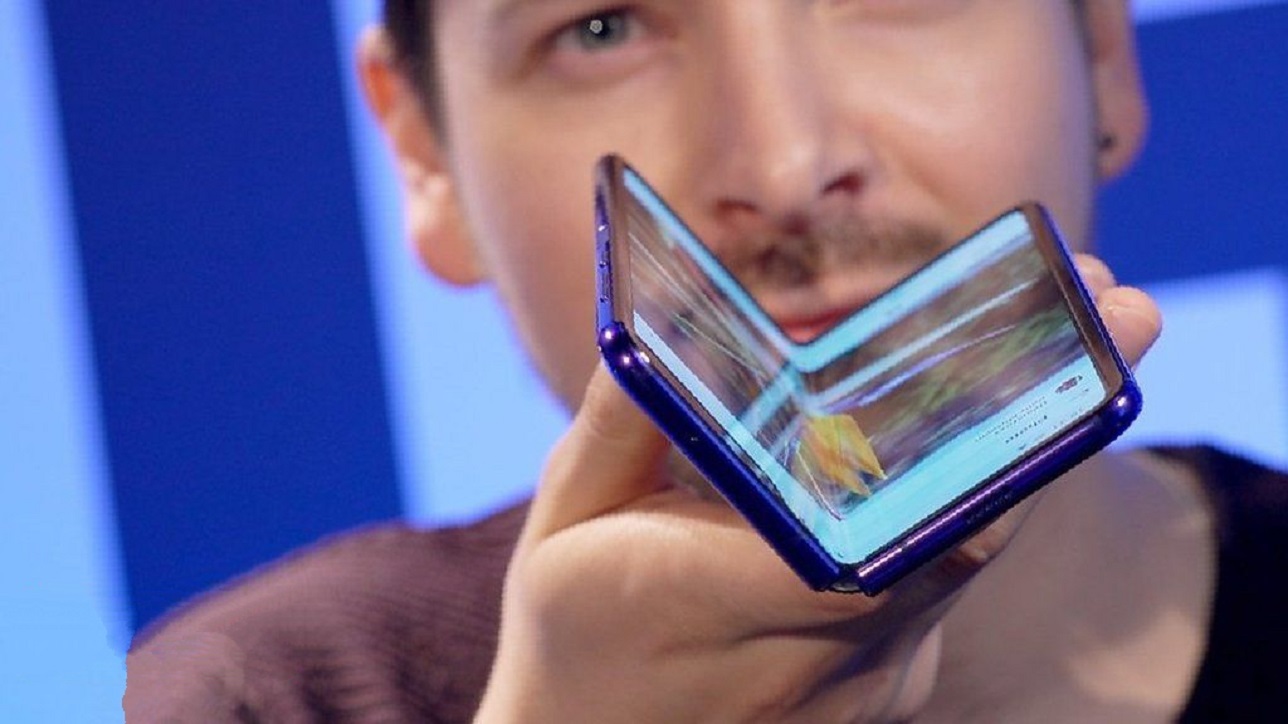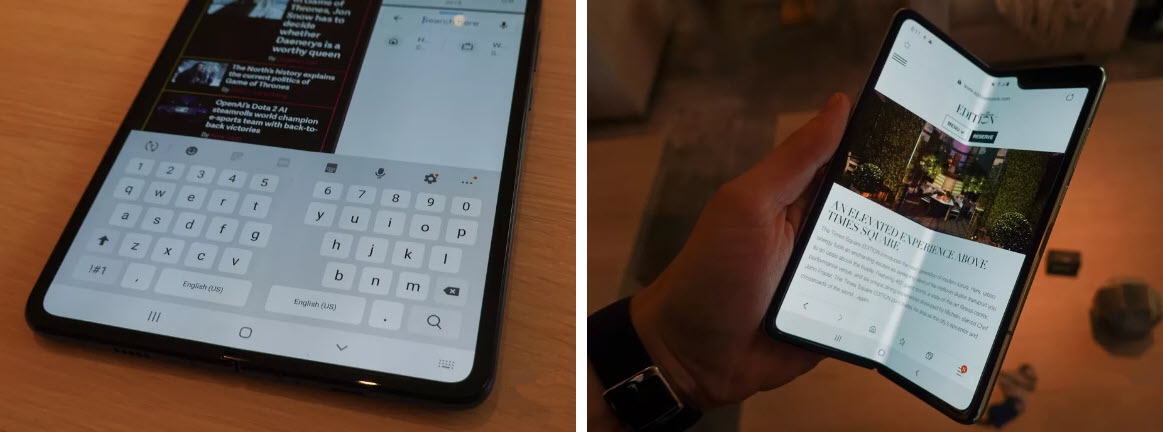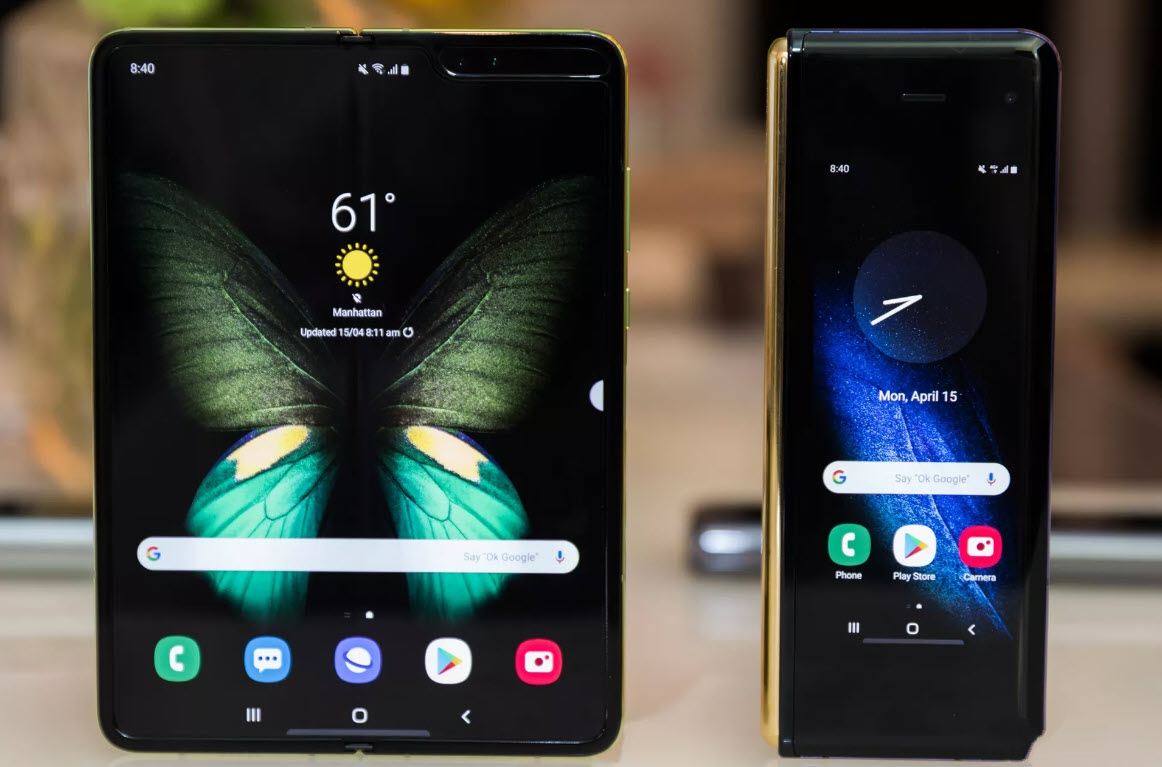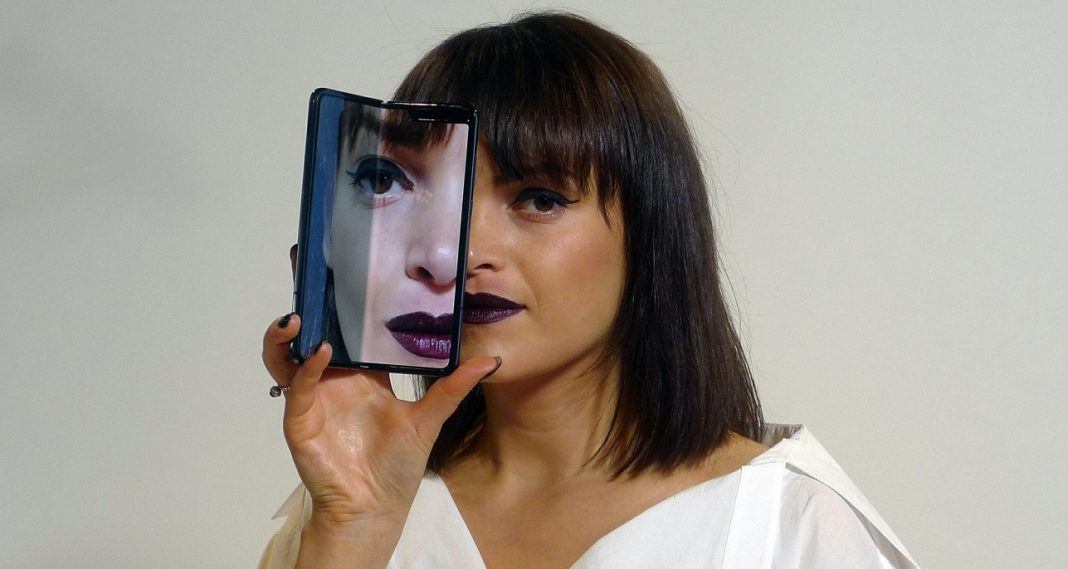
Back in February, Samsung announced the revolutionary Galaxy Fold smartphone aka phablet, but we weren’t able to get our hands on it. Now, right before the company unleashes it for $1,980, we were able to get our hands on it to put it through its paces.
When Samsung said this year it would launch a smartphone with a folding screen, the big question was whether the innovation was something people actually wanted or needed.
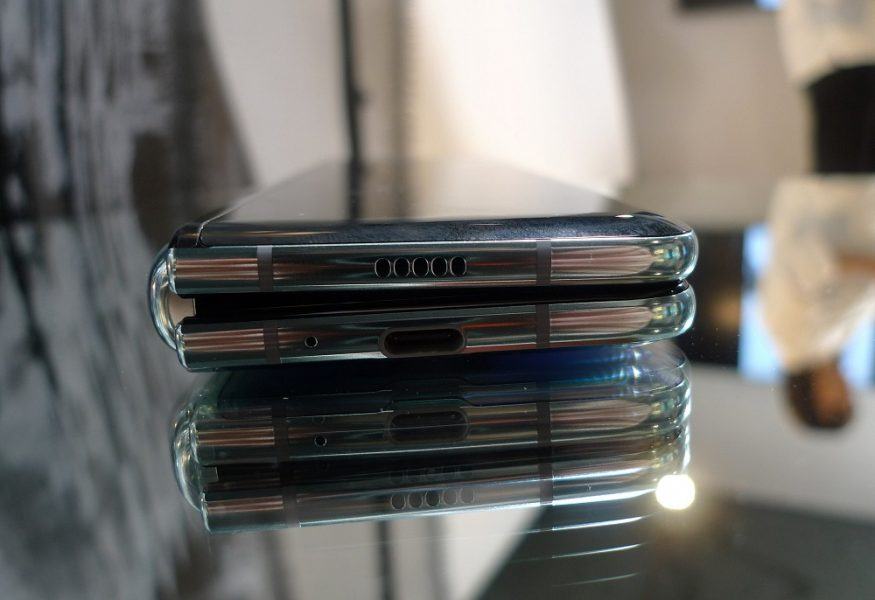
Is the Galaxy Fold a gimmick to help sell more smartphones in a slowing market or a true breakthrough that will change how we use our devices?
Major manufacturers have in recent years been largely updating smartphones with marginal improvements like better cameras and face scanning technology, so skepticism has been high.
The South Korean electronics company this week offered the media a hands-on preview ahead of the release in the U.S. this month, and the first impression is that a folding screen in some circumstances might be a useful innovation — but at a cost of almost $2,000 it won’t be a mass market product anytime soon.
WHY A FOLDABLE SCREEN?
As people increasingly use their phones to do data-hungry tasks like view photos on Instagram and watch movies or TV shows on YouTube or Netflix, Samsung says the case for a folding phone has become clear: People want bigger screens but they also want a phone they can carry around in their pocket.
Skeptics might say that folding phones are a sign that the smartphone industry has run out of good ideas and fallen into an innovation malaise. Samsung isn’t alone. Little known Royole started selling its FlexPai in China last year while Chinese tech giant Huawei announced its own folding phone, the Mate X, days after Samsung’s announcement.
Buying the first iteration of any new kind of gadget is fraught with risk. And the Fold is a first: it’s a phone with a 4.6-inch screen that folds out to reveal a 7.3-inch tablet inside. That’s how we’ve all thought of it, anyway: as a folding phone. But after using the Galaxy Fold for about an hour today, I’ve started to come around to thinking of it as a small tablet that happens to fold up.
That change in perspective makes a big difference in terms of the physicality of the Fold. If you think of it as a phone, it’s ridiculous. It’s super tall and much thicker than any phone out there when it’s closed. There’s a little gap when you fold it up because the screen can’t be fully folded flat. The front screen is tiny. Even though it’s 4.6 inches, it feels much smaller because it’s so narrow and because it sits inside such a tall phone.
But if you think of it as a small tablet that happens to fold, all of those foibles start to feel less like foibles. Instead, it’s like you have an iPad mini that can be packed down to become more pocketable. I say “more pocketable” intentionally. It’s large enough that it’ll stick out of any but the deepest pants pockets. This is a device designed for a purse or a coat pocket.
The hinge mechanism is really solid, too. It closes with a satisfying snick, and it has a springiness to it when you open it up. There are some magnets that hold it firmly closed, and, try as I might, I haven’t been able to open it up one-handed. But I have been able to hold it one-handed, even when open. It really does feel like an itty-bitty tablet, which is not a form factor I expected to want, but it feels more useful the longer I hold it.
OPEN AND SHUT
Closed, the Galaxy Fold is about 6.3 centimeters wide and 16 centimeters long (2.5 by 6.3 inches). It felt like holding a TV remote control, but heavier. The phone’s two panels are held shut by magnets, so a bit of force is needed to get it open. With a little practice I was able to do it one-handed by jamming my thumb between the two sections to pop them apart.
Samsung spent nearly five years working on the hinge, which went through more than 1,000 prototypes. It uses cogs and gears to give it a smooth feel and has two open positions. First, it unfolds to 140 degrees — handy if you want to put it down on your desk but still need to angle part of the screen for a video call, for example. Bend it further and the screen silently and solidly opens to a flat position. To close the phone, you click it out of the open position and snap the sides shut.
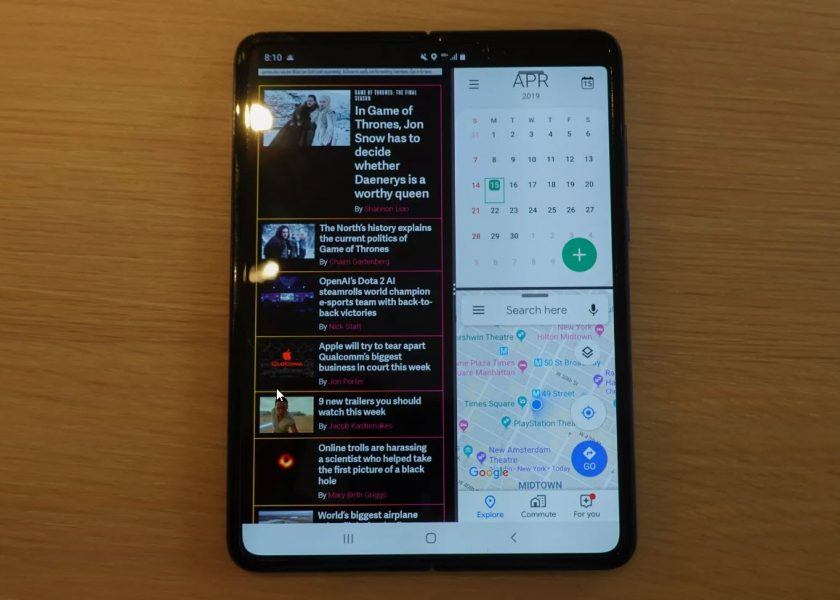
SCREEN TIME
Fully open, there’s plenty of real estate on the Galaxy Fold’s main screen, which measures 7.3 inches (18.5 centimeters) diagonally. It’s great if you want to take and review photos, watch videos or read e-books without squinting. Multi-tasking is also possible with up to three apps open at the same time. Wide open, the Fold felt more like a small tablet than a smartphone, which suggests that one possible market is people who want both kinds of devices but don’t want to buy two.
As with anything that folds, there’s a crease. It runs down the center of the screen and is visible at certain angles, though I didn’t really notice it when using the apps. Samsung developed a new adhesive to glue the composite polymer screen together, and promises it can withstand being opened and closed 200,000 times, or 100 times a day for five years.
The Fold has a second screen, a long, narrow display, on one of its outer panels, so you can continue using apps while it’s closed. I tried out a few — YouTube and car racing game “Asphalt” — that transitioned seamlessly between both screens. It could, for example, be useful to consult Google Maps in detail on the big screen before setting off, then put it in your pocket and quickly check the directions en route. But I’m still not convinced that “app continuity” is something I need.
The phone’s specs have been available to app makers for a while and the company says most should only need a few tweaks to run properly on its Android operating system. Hundreds of apps have already been “optimized” for the Fold but Samsung won’t say how many until it’s released.
That brings me back to that screen: it’s 7.3 inches in a nearly 4:3 aspect ratio. It gets plenty bright, and you can use it fully flat or with the Fold sort of half-open like a paperback book. As I said above, you can see the crease from an angle, but it mostly disappears when you are looking at it head-on. You can also feel the crease, which is a little disconcerting. But you get over it soon enough. It’s easy to be picky when you first try it out, but after some use, it just becomes natural.
CAMERAS AND MORE
The Galaxy Fold has no less than six cameras. Three lenses on the rear, another on the cover next to the second screen, and two more inside, including a selfie camera. There’s a fingerprint scanner on the right side, which can be used when it’s both open and closed. Inside, the battery is split in two, one in each panel, and it has enough juice to wirelessly charge another device, such as the wireless earphones included. It’s not clear if the bigger screen needs more power — Samsung hasn’t given any battery life estimates, saying only that it may vary.
There’s also that notch in the upper right corner, which houses the two cameras and various proximity and light sensors that every phone needs. That notch does get in the way sometimes. YouTube, for example, was cut off on full-screen videos, although Samsung will allow you to hide the notch with a black bar across the top of the display, similar to its current Galaxy devices. Samsung also had to do some extra work to make the screen flexible that you might not have thought of. For example, the adhesive that holds the different screen layers together had to be completely redone.
In terms of software, things are in a range I’d call “surprisingly acceptable.” That’s faint praise for any software, but here, I don’t mean it as an insult. Android has historically been awful on tablets, but the screen on the Fold is small enough that it doesn’t make a big difference. There’s “App Continuity,” Samsung’s branding for a Google Android feature that allows the app you’re looking at on the smaller front screen to automatically open up on the inside, properly resized.
On the back, you’ll find a three-camera array: one regular, one telephoto, and one wide angle. When the phone is closed, there’s a single front-facing 10-megapixel lens. When you have it opened to tablet mode, there’s a giant notch that houses yet another camera plus an RGB depth-sensing camera.
That’s technically six cameras, which is probably too many cameras. I would have preferred it if Samsung had chosen to just put a single small webcam inside for tablet mode and put the dual cameras on the outside, if only because it would reduce the size of the notch.
App Continuity
Properly resizing apps has been an Android bugbear since forever, but Samsung and Google have worked together to fix that for a lot of apps. A side effect of that work is that Samsung is able to let you do two- or three-tiled, split-screen apps. You slide over from the right edge of the screen to pull up a dock of the recently used apps and tap one to open it up in a split view. Then you can do it again to open up a third one, which is split on the right.
Active windows are indicated by little lozenge-shaped bars at the top of each app, and you can tap on them to slide apps to different positions or open up yet more windowing options. You can open up literal windows if you really want to, dragging them around the screen and resizing them.
All of this should be familiar to Samsung fans, as these features are based on a lot of the popover and windows work the company has introduced with its One UI software. But for everybody else, it could be a little confusing. Finally, there’s no getting around the blunt fact that Android apps are not as good on big screens as iPad apps. But, again, it’s not so offensive since this screen is a bit smaller.
And if you’re a Samsung fan, you might be interested to hear that the fingerprint sensor button is also the Bixby button. Above that is where you’ll find the traditional power and volume buttons. It’s not a big deal, but I’m so used to the concept of a fingerprint sensor button also being the power button that I got tripped up a little.
In terms of specs, the Galaxy Fold is very similar to a Galaxy S10 Plus. It has the same Snapdragon 855 processor, 12GB of RAM, and 512GB of storage. The cameras are similar to what you’d find on that phone, too, but there are more of them. The battery is 4,380mAh, with cells on both sides of the fold. Whether that’s enough for Samsung’s claimed full-day of use on a screen this large is anybody’s guess. The S10 tech that it’s based on has comported itself fairly well in terms of battery life, so there’s some reason to be optimistic.
WHEN
The Galaxy Fold is set for release in the U.S. on April 26, priced at $1,980. It goes on sale in some Europe markets on May 3.
Should You Get It?
Yes, there are rough edges in the software, and the folding screen doesn’t feel as premium as other screens in this price category. There are still plenty of reasons to turn your nose up at the Galaxy Fold, especially at a price of $1,980.
But you shouldn’t turn your nose up at the whole idea. Samsung has accomplished something special here, even though there’s more work to be done.
It’s a totally working folding phone. That’s amazing. Whatever turning your nose up you want to feel about its issues, you won’t be so snarky when you open it up for the first time. If you recall, I was a little snarky in my February overview, but Samsung has made me a believer again! Let the folding wars begin as Huawei has a really great one too.


